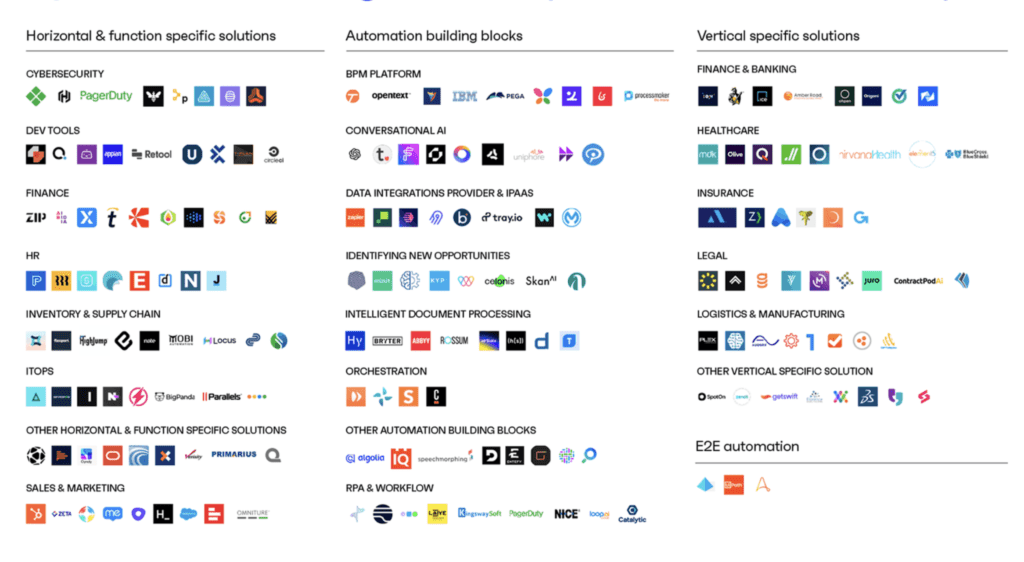
Table of Contents
- What is Enterprise Automation?
- Fundamentals of Enterprise Automation
- Types of Enterprise Automation
- Technologies Driving Enterprise Automation
- Benefits of Enterprise Automation
- Use Cases of Enterprise Automation
- Top Enterprise Automation Tools
- The Future of Enterprise Automation
- The Bottom Line
In today’s fast-paced business landscape, simply managing day-to-day tasks isn’t enough. Organizations face increasing pressure to streamline operations, respond swiftly to changing conditions, and deliver outstanding experiences—not just for customers, but for employees as well.
Automation is key to achieving these goals. However, given the vast array of automation solutions available, just getting started can feel overwhelming, especially for enterprises with existing systems, processes, and tools.
This guide offers a comprehensive overview of enterprise automation:
- Explore the fundamentals of enterprise automation.
- Examine the different types of enterprise automation.
- Review practical examples of automation in the enterprise.
- Consider leading enterprise automation tools.
Informed with these insights, you’ll be ready to embrace the power of automation across your organization.
What is Enterprise Automation?
Enterprise automation is the use of technology to perform regular, recurring tasks or processes in a business where manual effort can be replaced. It is done to achieve cost minimization, greater efficiency, and improved workflows.
While business process automation (BPA) focuses on the automation of individual processes, enterprise automation goes one step beyond BPA by helping businesses integrate multiple systems and applications to fully automate their operations.
Here’s an example:
- BPA could automate individual processes such as an HR professional sending out a DocuSign contract to a new hire.
- Enterprise automation could look like an entire onboarding process, where confirming and signing sends that information to a number of other apps built into the process.
Enterprise automation enables organizations to operate more efficiently, achieve faster time-to-market, respond better to customer and employee needs, and deploy easily while discovering newer and simpler team innovations—all leading to better business outcomes.
Fundamentals of Enterprise Automation
Automation platforms and tools are often used within different departments in an organization to have reliable systems in place, but also to ensure top-tier quality control and well-defined back-end processes. In fact, there are many different approaches to automation one can take, from “basic” to “intelligent,” and even hyperautomation.
No matter the approach, these platforms and tools typically aim to eliminate redundant manual work, optimize and streamline multitasking for speed and efficacy, and extract and better leverage collected data to improve processes, products, and experiences.
But enterprise automation cannot just operate within silos of individual teams or departments. Ideally, the IT department works closely with the business side and coordinates with individual teams on their unique needs and objectives. It may also require collaboration and a cohesive mindset among department heads.
Key Concepts
Enterprise automation enables businesses to streamline repetitive tasks and better leverage their collected data.
The business landscape is constantly changing; you can never predict what’s going to happen next, but there are always ways to prepare. And no matter how severe or complex the economic landscape becomes, businesses will always need to find ways to do more with less, make scarce resources go further, and invest in the appropriate tools and infrastructure to help their business pull through.
Automation works by using machine learning and other technologies to take repetitive, often mundane tasks and create self-operating systems and processes to complete these. This reduces the chances for human error, increases workers’ productivity without increasing costs, and allows information to flow quickly and easily between different departments to break down silos, which helps overall business performance.
Enterprise automation can facilitate profound improvements to operations, allowing businesses to carry out key functions faster and at a lower cost, while increasing performance, quality, and overall experience. Existing core systems can become substantially more efficient and effective, and connected devices—from the factory floor to patient bedsides—will be able to seamlessly and securely pass information over the network to enable more intelligent and effective actions.
Objectives
With a well-planned and executed enterprise workflow automation system, businesses can aim to reduce unnecessary human intervention, error, and time spent on redundant tasks; cut overall costs and operational expenses, and increase their ROI; increase speed, convenience, and coordination for greater overall performance and efficacy; and allow employees to focus on more important, creative, and interpersonal aspects of their roles, instead of repeatable, menial, and error-prone tasks.
Still, companies must understand that these efforts take both time and proper planning. And they can’t happen in a vacuum: in order for this to work, business and IT teams must work hand-in-hand to define their goals and the actions, tools, and specific elements needed in order to bring these process automations to life. They must also work together to ensure that all levels of the business and the entire team are aligned and collaborating to prioritize these goals, innovate, and create a culture that is transparent and trusting.
Let’s dive deeper into today’s top automation types and the technologies that power them.
Types of Enterprise Automation
1. Basic Automation
Simplifies and centralizes routine tasks to take up less time. While it is the “simplest” form of automation, it can still deliver significant value and efficiencies.
2. BPA (Business Process Automation)
Automates complex business processes to work more efficiently and strategically, and to adapt to the changing needs of a business with built-in functionality and strategic benefits. Think of BPA as end-to-end automation—for example, the entire order processing or manual PR-compiling process is done without any manual intervention.
3. Integration Automation
Allows machines and software to observe how employees perform specific tasks, so they can repeat those tasks as stand-alone systems. Employees must define the business rules and logic, as well as the inputs and outputs of specific tasks. Ensures that systems used across the business are all connected and working together seamlessly, without any information or work lost in the process.
4. RPA (Robotic Process Automation)
Automates high-volume, repeatable tasks—those that would otherwise need to be performed by a human worker. RPA can function, in some ways, like a virtual assistant for a number of tasks across teams. Think of RPA as something that mimics human interaction, such as scraping the internet for certain topics and using NLP to craft a short list of news articles on that subject.
5. Intelligent Automation (IA)
The most complex form of business automation (sometimes referred to as “cognitive automation”); it combines AI, BPM, and RPA functionalities to create an automated intelligence capable of processing both structured and unstructured inputs. Can execute pre-programmed rules and learn how to execute or respond to new inputs over time.
Technologies Driving Enterprise Automation
Benefits of Enterprise Automation
The benefits of enterprise automation are profound and far-reaching. For many organizations, these advantages could be the very thing that helps their business persevere through shifting times:
- Operational efficiency: Standardizes best practices across your organization to make every process work faster, so your team can focus on the tasks that matter most.
- Flexibility and resiliency: Streamlines processes across your business so you can respond better to customer, partner, and employee needs, no matter how things are shifting around you.
- Time to value: Removes heavy development cycles through no-code solutions that any decision-maker can implement to expedite time to value.
- Simplified processes: Gives anyone the power to automate, from decision-makers to developers, to improve and simplify your team’s processes and workflows.
- Increased capacity for innovation: Frees up employees to focus on the challenges that matter most, instead of getting bogged down with repetitive manual work.
- Better experience: For employees, customers, partners—the list goes on. Automation supports communication, connection, and collaboration by enabling experiences to be safer, timelier, more pertinent, and personalized to the user.
Use Cases of Enterprise Automation
Regardless of size, shape, location, or industry, organizations across the map have begun their journey into enterprise automation to drive better results for their customers, employees, and business as a whole.
Some examples of how companies are finding success are:
- At computers and workstations: Automated processes such as onboarding and time tracking solutions can help HR teams redirect their energy toward creating a better remote work culture and experience for employees.
- In conference rooms: IT teams can automate compliance with smart security tools and instantly set up, manage, monitor, and control room devices no matter where they work, to help protect sensitive company and employee data.
- At data centers: IT teams can automate routine network security updates and perform automated tests to help ensure backups are functioning optimally, and data is stored securely and accessible remotely.
- On the factory floor: Intelligent robots and other mechanical innovations can help factory workers by increasing production safety, speed, and efficiency. What’s more, connected systems can help monitor factory equipment in real time so that issues can be addressed proactively instead of reactively.
- In warehouses: Automated systems can help monitor inventory in real time so that issues like outages and stocking issues do not impact the distribution line or final customer experience. Automation can also sift through massive stores of customer data to help create a more personalized shopping experience that today’s consumers expect.
- At the point of care: Technology like AI, machine learning, and NLP can help hospitals and healthcare providers onboard new patients quickly and put them in front of the physicians or specialists who they need, sooner.
- On trucks and shipments: Sensors on a vehicle can collect data and send signals through the vehicle’s communication network, which are then sent back to the manufacturer—all with the consent of the driver.
These processes can be automated to operate across departments—including HR, finance, data security, marketing, sales, IT, and more. However, it’s important to note that a major factor that differentiates enterprise automation from BPA is the notion that these automations should also interact and operate with each other to create entirely seamless end-to-end automations across the business.
Over time, as conditions continue to shift and businesses gain more access to the right tools, timely insights, and team members with the right skills, machine intelligence will become even faster, smarter, more accurate, and more accessible. It will help businesses transform processes, products, services, and experiences by uncovering, analyzing, and acting on the right business-critical insights.
Top Enterprise Automation Tools
Enterprise automation software can streamline your company’s workflows, transitioning from isolated tasks to a cohesive enterprise automation strategy. Automation software is the most effective approach to eliminate friction within your business and create a smooth, delightful experience for your customers.
Let’s explore the top enterprise automation tools that businesses rely on to automate repetitive tasks and business processes without the need for complex code.
1. Microsoft Power Automate

At its core, Microsoft Power Automate—a key element of Microsoft’s suite of Power Platform solutions—is an enterprise automation platform that can modernize paper-based systems and processes for all types of businesses, from healthcare to sales to finance and beyond.
Why do 97% of Fortune 500 companies trust Power Platform? It all comes down to the balance of enterprise-class capabilities and next-level ease of use.
- Enterprise-class AI, built right in. Quickly extract insights—from text in emails, to numbers in invoices, to social media sentiment—and quickly translate that data into what your business needs to move forward.
- Connect everything. With thousands of different connectors through Power Automate and Power Platform—and the ability to create your own—your Microsoft solutions and business intelligence tools can integrate deeply with the solutions you use every day.
- Unmatched ease of use. Everyone from your decision-makers to pro developers can create the solutions they need to work more efficiently, right from day one, with no or low-code tools.
- Built with security in mind. Power Automate complies with more than 300 state, local, and international standards and protects both your and your employees’ rights by adhering to strict security and compliance measures.
- A leader in the enterprise automation space. For the fourth year in a row, Gartner has recognized Microsoft as a Magic Quadrant Leader for Enterprise Low-Code Application Platforms 2022.
2. UiPath
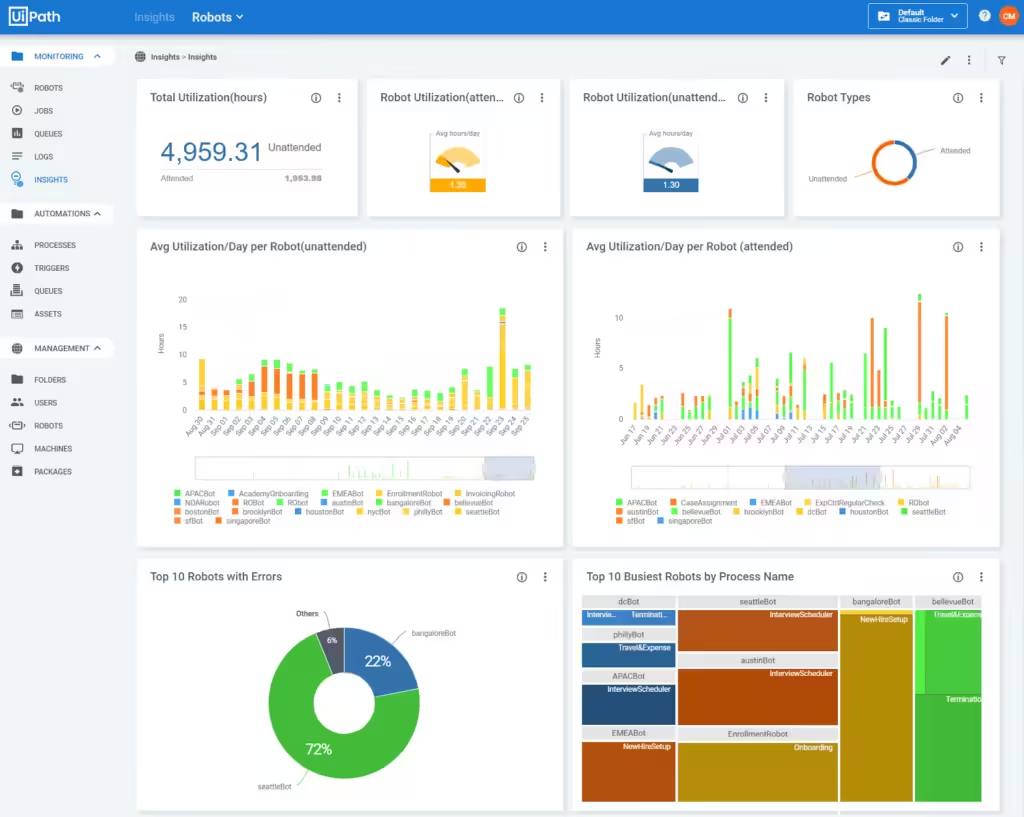
UiPath is one of the top robotic process automation solutions available today, recognized by Forrester as one of the only RPA leaders in both strategy and market presence. RPA bots can take over the performance of routine tasks and audits, rather than using a human worker.
A process mining tool is also included in the enterprise automation platform to measure efficacy and track updates and improvements. It’s also one of the few RPAs that offer native cloud robots to help with scaling.
3. IBM Automation Platform

The IBM Automation Platform is a set of integrated, AI-powered enterprise automation capabilities that help you automate repetitive human tasks, streamline business processes, and ensure business operations have the resiliency they need to keep running.
Examples of each of IBM’s automation offerings include:
- IBM Robotic Process Automation: To automate routine human tasks performed on a computer, such as entering data into a form or copying and pasting information across multiple applications.
- IBM Business Automation Workflow and IBM Business Automation Studio: To automate business processes from the straightforward to the complex, such as managing approvals for invoices or onboarding employees.
- IBM Business Automation Application: An integrated environment for deploying easy-to-update applications to automate repeatable tasks, like opening a savings account at a bank or configuring a product for a customer.
4. Automation Anywhere
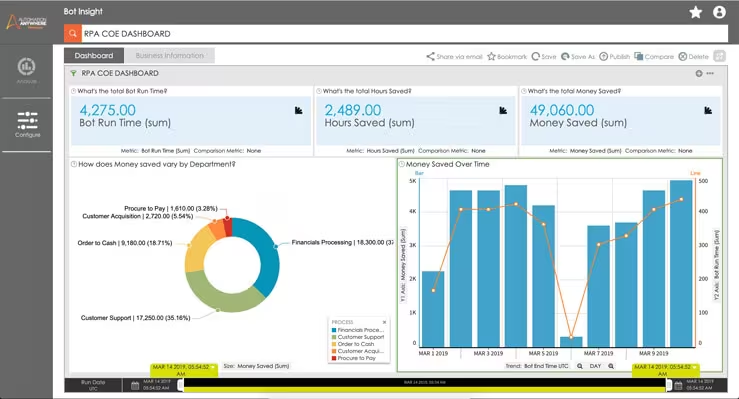
Automation Anywhere is an end-to-end automation solution provider that gives businesses the power to create smart automations with RPA, artificial intelligence, and machine learning. It’s worked with more than 90% of the world’s leading accounting, advisory, and tax firms to create enterprise automation solutions that help organizations thrive.
The enterprise automation platform employs a digital workforce to take on repetitive tasks across a number of industries, including banking, financial services, and insurance; higher education; and high tech and telecom. It also offers cloud-native intelligent automation for scaling automation across a business or across various industries.
5. Nintex

With powerful tools that are easy to use, allowing you to get up and running quickly, no matter where you sit in your organization, Nintex allows you to hit the ground running when it comes to BPA (business process automation).
Its enterprise automation platform offers solutions for process management, workflow automation, robotic process automation, document automation, and more, tailored to the unique needs of various industries—featuring the likes of Amazon, Facebook, and Adidas.
6. Kissflow

More than 10,000 companies around the world—including Pepsi, Comcast, and HubSpot—use Kissflow for end-to-end process automation and management. The platform is available from anywhere, at any time—which means users can perform approvals directly from their mobile devices.
Access to custom reports and advanced analytics help you keep track of business process performance, review, and refine. Built-in integrations connect seamlessly with third-party systems like QuickBooks, G Suite, Salesforce, and more, so you can connect all of the tools you rely on for continuity and visibility.
7. Pega Platform

Pega provides a market-leading, AI-powered decisioning engine to deliver timely, relevant, and contextual experiences that boost retention and customer satisfaction. While its no-code platform makes it easy for users to create straightforward applications in minutes—the enterprise automation platform fully supports augmented, intelligent, and robotic process automation; workforce optimization and engagement; natural language processing; business rules and policy management; and more.
Pega has been named a Leader in the Gartner Magic Quadrant for intelligent business process BPMS for the thirteenth year in a row, and was ranked as having the highest ability to execute.
8. ServiceNow Workflow
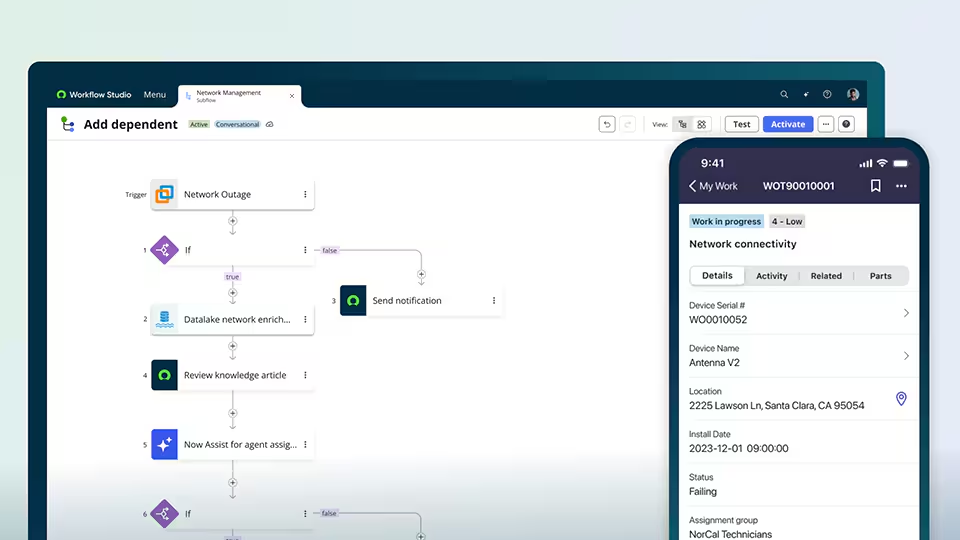
ServiceNow’s flagship Position Intelligence technology allows businesses to manage cross-platform spaces and resources efficiently from a smart floor plan. It gives you the visual context you need to move, manage, and track resources directly from a floor plan, ensuring you have the sufficient capacity and resources you need to automate business processes with accuracy and efficiency.
ServiceNow helped L’Oreal create a human resources service delivery system that enables their employees to submit HR requests through a web portal that automatically routes to one of seven regional centers around the world, for a more seamless, end-to-end experience. Now, L’Oreal employees no longer have to worry about getting their questions and requests to the right person or team—and they’re able to get the support, feedback, and answers they need far more quickly.
9. Trudo

Trudo is changing enterprise automation in ways we hadn’t even imagined. Trudo is the first and only platform to integrate a powerful AI Copilot that helps you create intricate workflows and seamless integrations—not with code, but with natural language. The use cases and powerful advanced features of this enterprise automation tool are limitless and transcend industries—its security, control, and visibility allow businesses to create smart automations with their favorite tools.
For example, Trudo allows you to trigger a workflow based on something happening on an application that you use every day—like Microsoft Teams, SharePoint, Notion, or Power BI. From there, you can perform a complex sequence of cross-product tasks automatically.
What’s more, with the Trudo platform, you can keep humans in the loop with human-in-the-loop actions, bring your AI workflows to life in a chatbot, secure all your credentials in the enterprise automation platform’s encrypted vault, and store unlimited data in the cloud to create customized automations.
10. Workato
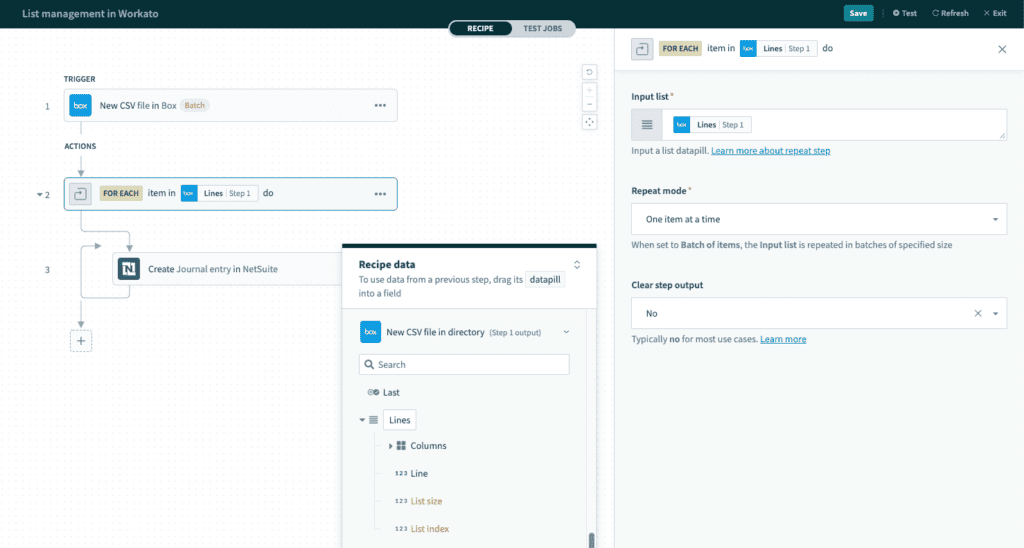
Workato, a relative newcomer in the RPA space, has quickly been adopted by some of the largest companies, including HubSpot, Box, and Slack. The enterprise automation platform combines an integration platform as a service, API-led integration, and artificial intelligence to create powerful AI automation, learning from human tasks to automate work and make recommendations.
It features hundreds of thousands of available integrations, including intelligent connectors for Salesforce, HubSpot, Workday, and more. Its customizable “recipes” feature helps users create automated workflows across departments, from marketing and human resources to finance and support efforts. And users looking to integrate without code can take advantage of its library of over 500,000 ready-to-use recipes.
The Future of Enterprise Automation
AI is one of the top technologies that has transformed our economy within the last few years, and it will only become more powerful as time goes on. It helps us break down big data, process information, make decisions, and predict based on what is happening now and what may happen in the future—and it can do it all at a rate, and with an accuracy, humans will never be able to replicate.
In line with this technological breakthrough, over the next few years, we’ll continue to see an uptick in intelligent and cognitive automation solutions being adopted across industries, further embedding AI in everything. This trend, known as “hyperautomation,” will combine tools like machine learning, AI, and Robotic Process Automation (RPA) to deliver accurate and efficient performance and work.
As it does, businesses will be challenged to create a collaborative, data-driven culture of close to constant improvement, alignment, experimentation, and optimization. They will need to learn from data—and from one another—to transform information into insights, insights into actions, and actions into better experiences for all.
The Bottom Line
Today’s modern marketplace is busier, faster, and more interconnected than ever before. With the onslaught of information happening in today’s digital age, businesses must work toward having an automated enterprise, or organized and standardized operations through the use of technology.
To prepare for this world, businesses across industries and geographies will be challenged to think critically about their existing digital landscape and core systems, drive full process and workflow automation across the organization, and embrace the notion that they are a part of a larger, connected entity that processes large amounts of data and information—which must be analyzed, safeguarded, and put to use in order to thrive and survive.
With an enterprise automation solution—like Microsoft Power Automate and AI Copilot—you can automate repetitive tasks for your organization for ultimate productivity, efficiency, and business continuity. And better yet, with compliance coverage around the world, robust privacy protection and security measures, and built-in accessibility—you’ll be able to do so in a trusted and responsible way.
Therefore, enterprise automation aligns with strategy and collaboration for a cohesive, efficient business. No matter the need—simplifying time-consuming manual tasks, connecting legacy and modern systems to do away with outdated processes, or allowing for intelligent and autonomous decisions and actions—automation accelerates how work flows across your entire organization, so you can better adapt to the complex changing environments you’re facing today.